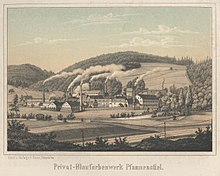Low pan handle
|
Low pan handle
City of Aue-Bad Schlema
Coordinates: 50 ° 35 ′ 8 ″ N , 12 ° 43 ′ 9 ″ E
|
||
|---|---|---|
| Height : | 380 m | |
| Incorporation : | 1922 | |
| Postal code : | 08280 | |
| Area code : | 03771 | |
|
Location of Niederpfannenstiel in Saxony |
||
|
Today's Nickelhütte Aue on the Zwickauer Mulde, the most important commercial enterprise in the Niederpfannenstiel district.
|
||
Niederpfannenstiel has been part of Aue in the Ore Mountains since 1922 . Together with the Neustadt, the former manor district forms part of the city center of Au. With the founding of the large district town of Aue-Bad Schlema in January 2019, Niederpfannenstiel became a district of the new district of Aue.
history
Niederpfannenstiel was built as a small settlement around 1635 for the people of Veit Hans Schnorr the Elder. Ä. founded the first large paint mill in Saxony, from which later a blue paint factory and today's nickel smelter emerged. The number of inhabitants was constant between 60 and 70 until the end of the 19th century. They lived in three groups of houses around the actual estate , around the paint mill and at the entrance to Bärengrund . The inhabitants belonged to the Evangelical Lutheran parish of Lößnitz , were given their own cemetery laid out by the blue paint factory in 1867 and a mourning hall outside the actual cemetery grounds in 1890 . The cemetery area was 640 square meters. Because of the small population there were only a few burials, so in 1934 three people were buried, in 1935 two people. The last funeral took place in 1954. At the request of the residents, responsibility for the cemetery was transferred from Lößnitz to the parish of Aue -zelle in 1923. This looked after the cemetery until 1972, then it was closed because the nickel smelter set up a paint store on the area. All graves were leveled, and the community fulfilled ongoing contracts by moving them to the municipal Nicolai cemetery on Schwarzenberger Strasse.
After the fall of the Wall , the nickel smelter dismantled the paint store and leased the site to a trader for a short time. When he had to give up the location, the area became a parking lot, which the employees of the nearby quarry use.
For recreation in leisure time, an English garden was created between Schwarzwasser and the ditch of the blue color factory. At the beginning of the 20th century the park was abandoned and built on. In 1921 a total of 184 people lived in 14 houses. In 1922 Niederpfannenstiel was incorporated into Aue. The oldest half-timbered building by Niederpfannenstiel, which was built in 1784 and bears house number 10b, has been preserved on the former Bärengrund am Rumpelsbach.
The name of the place is related to its location on an elongated mountain ridge and an almost circular bend in the black water, the so-called hook bend . Already in 1522 there is talk of a tunnel on the Pfannenstielh . In the course of the 18th century, the names Niederpfannenstiel (for the older one) and Oberpfannenstiel (for the new settlement) became established to delimit the current district of Bernsbach , which was founded in 1691 in the forest above the Pfannenstiel .
Personalities
- Kurt Alexander Winkler (1794–1862), chemist and metallurgist, died here
- Clemens Winkler (1838–1904), discoverer of the chemical element germanium, spent his childhood and youth here
- Richard Beck (1858–1919), geologist, was born here
literature
Aue, mosaic stones of history , published by Stadtverwaltung Aue, printer and publisher Mike Rockstroh, Aue 1997; Pages 64/65
Web links
- Niederpfannenstiel in the Digital Historical Directory of Saxony
Individual evidence
- ↑ Source on the history of the cemetery: written information from the mayor's press officer, Jana Hecker, (May 2009) or the pastor of the Aue-cell parish (from May 7, 2007)
- ↑ Cf. From Oberpfannenstiel to Catterfeld and Pissen ( Memento from January 17, 2005 in the Internet Archive ), broadcast on behalf of the MDR from July 28, 2004.
- ↑ Niederpfannenstiel in the Digital Historical Directory of Saxony


